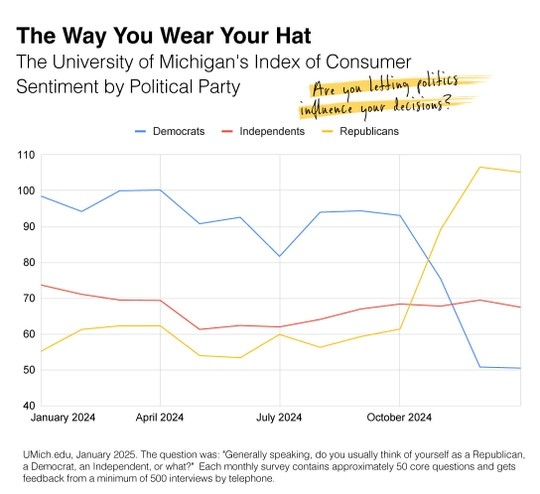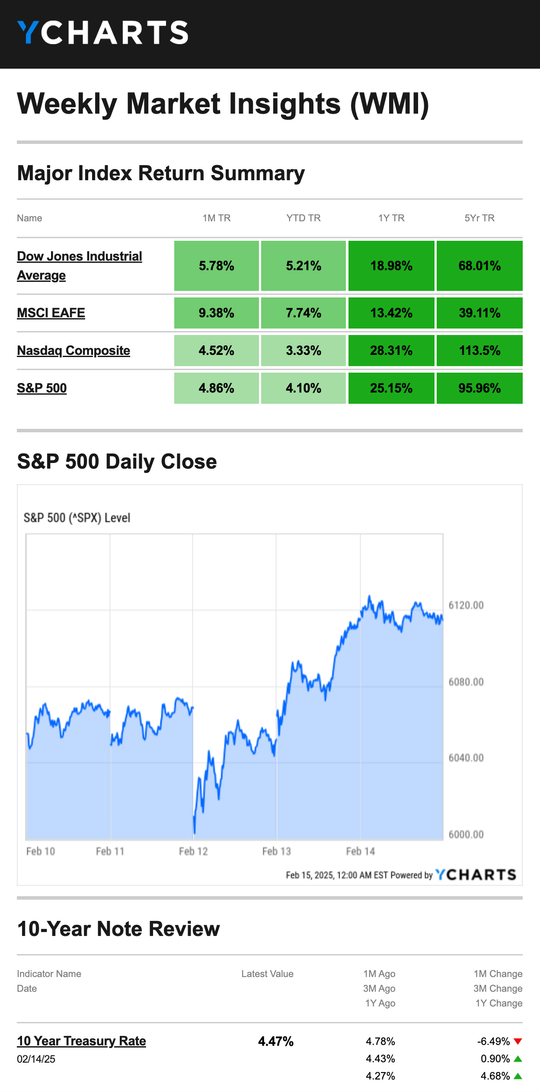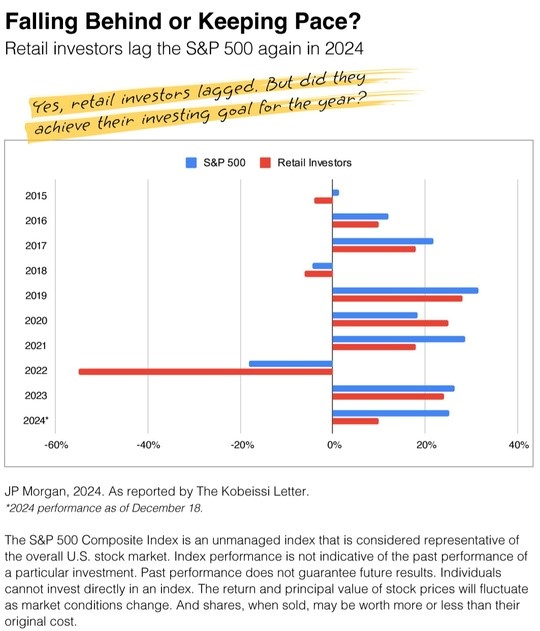The Politics of Consumer Confidence
Warren Buffett Says Don’t Mix Politics and Investing
Warren Buffett once said, “If you mix your politics with your investment decisions, you’re making a big mistake.” There appears to be some truth in Buffett’s quote following a contentious 2024 election cycle. Check out the chart below from the University of Michigan, which looks at consumer sentiment.
Consumer sentiment measures how individuals view their overall financial situation, today’s economic outlook and the prospects for the economy over the long term. As you can see, the outlook diverges when people are asked to self-report their political affiliation.
 This is a reminder that when it comes to investing, being too optimistic or too pessimistic can lead to hasty decision-making. A more balanced outlook is often best. If you struggle to strike a balance these days, please let us know. We can talk through your outlook and revisit our overall strategy that’s based on your goals, time horizon and risk tolerance.
This is a reminder that when it comes to investing, being too optimistic or too pessimistic can lead to hasty decision-making. A more balanced outlook is often best. If you struggle to strike a balance these days, please let us know. We can talk through your outlook and revisit our overall strategy that’s based on your goals, time horizon and risk tolerance.
Sources: UMich.edu, January 2025, “Index of Consumer Sentiment and Components by political party”
Market Insights
Stocks advanced last week despite some intra-week volatility as investors showed concern about the economy’s strength. The Standard & Poor’s 500 Index gained 1.47 percent, while the Nasdaq Composite Index picked up 2.58 percent. The Dow Jones Industrial Average added 0.55 percent. The MSCI EAFE Index, which tracks developed overseas stock markets, tacked on 2.53 percent.
The Fed Is in “No Hurry”
Stocks opened the week higher, quickly discounting news that the White House would impose 25 percent tariffs on all steel and aluminum imports. Tuesday was a volatility session, punctuated by comments from Fed Chair Powell, who told lawmakers the central bank doesn’t “need to be in a hurry” to lower interior rates further.
Stocks opened lower Wednesday after a warmer-than-expected update on consumer prices. But stocks showed some resilience and rallied throughout the day. The Nasdaq managed to claw back its losses before Wednesday’s close.
On Thursday, the White House announced a plan for reciprocal tariffs (levies on goods imported into the U.S. from countries that impose tariffs on U.S.-exported goods). But markets rallied on news that the administration would pause tariffs until they determine how much to levy on each country. Stocks took a breather on Friday, shrugging off a weaker-than-expected retail sales report.
The S&P ended shy of a record close, and the Nasdaq finished the week above the 20,000 mark.

Source: YCharts.com, Feb. 15, 2025. Weekly performance is measured from Friday, Feb. 10 to Friday, Feb. 14.
TR = total return for the index, which includes any dividends as well as any other cash distributions during the period. Treasury note yield is expressed in basis points.
Individual Investors Lagged Behind the S&P 500
“A goal without a plan is just a wish,” wrote French author Antoine de Saint-Exupéry in the 1942 classic, “The Little Prince.” In financial services, we like to say, “Investing without a strategy is just a dream.”
At its core, an investing strategy is designed to help you
- track progress toward your goal,
- define your risk tolerance,
- set your time horizon, and, perhaps most importantly,
- help define and measure your success.
The chart below shows fears about what happens when people invest without a clear, well-defined strategy. In 2024, individual investors again lagged the S&P 500. Fear, greed and overconfidence can cloud judgment and lead to poor decision-making and bad returns.

When Adams Brown Wealth Consultants create a strategy, we are clear about where you start and where you want to go. So, each year, we can measure your progress toward your goals. But life happens, and sometimes goals change. If you see any changes on the horizon for 2025, please let us know as soon as possible. We might need to revisit your approach. Ultimately, we want your investment strategy to help you realize your dreams—all of them.
Source: JP Morgan, 2024. As reported by The Kobeissi Letter.
